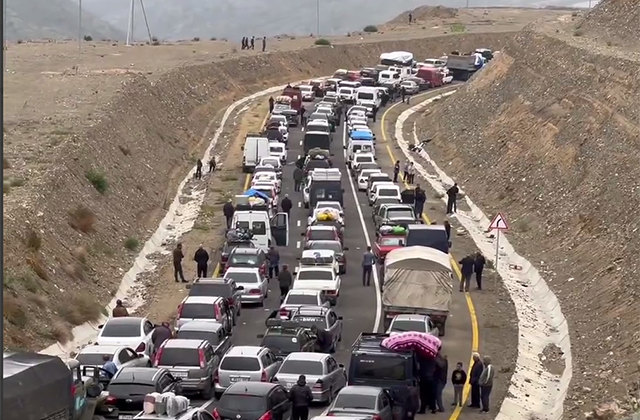According to official data, 100 thousand 625 people were forcibly displaced from Artsakh and moved to Armenia. The ethnic cleansing of Armenians from Artsakh [Nagorno Karabakh] lasted less than a week. The migration path was hellish for the people of Artsakh. In a conversation with Forrights.am, they describe terrible scenes.
There are testimonies that Armenians who were forcibly displaced died on the Goris-Stepanakert Road before reaching Armenia. Arayik Margaryan told Forrights.am that the woman was a victim of an accident on September 28.
“The cars were not moving in the morning. She got out of the car, and then, when she was coming back, she opened the back door to enter the car, a Kamaz [big truck] standing behind my car came and hit her: she remained between two cars,” the husband describes the tragic death of his wife.
The wife, Karine Margaryan, was 44 years old, the mother of three little children. The family lived in Stepanakert. After the Azerbaijani attack and the order to leave Artsakh against their will, the Margaryans, like hundreds of thousands of Armenians, got on the road to survival in Armenia. Little children too have witnessed the accident.
“I took the children to my friend’s car. The car that I was driving had the opportunity to lay down. So, I put her in my car and drove to Goris {district in Armenia bordering with Artsakh]. I buried her in Yerevan. Today marks the seventh day of her death,” Arayik tells with pain and remembers how he asked to be allowed to reach Goris in the endless traffic jams.
“After the incident happened, my friend was driving before me, getting out of his car and explaining everyone what has happened, so everyone gave us a way and we reached Goris on the same day,” he said.
Arayik worked in a demining organization. He reached Goris by a company car. The employer rented a temporary hotel room for them. However, he notes that not only the death of his wife, but also the misfortune that happened to his elderly father were added to the severe social and psychological consequences of forced displacement.
“My father also fell on the road, got bone fractures, is in the hospital. He needs to have an operation. Besides that. he has other problems too,” he said.
He registered his wife’s death before the Hakari bridge. When Arayik arrived to the checkpoint, the Azeerbaijani soldiers did not easily allow him to pass with the wife’s body.
“Azerbaijani soldier came, stuck his head into the car and said, ‘What is this?’ I explained what happened, he let us pass. But there was another man who told us to get out of the car. Whatever, eventually we passed,” he notes, adding that now he will try hard to take care of of three children, elderly father and mother. He just wants to have a roof above the family’s head so that his children do not stay outdoors in these difficult conditions.
Forrights.am learned about other deaths registered on the way of relocation. Narine Safaryan, who was displaced from Chartar, assured us that she had witnessed four death cases before reaching Vayk.
“On the Stepanakert-Goris Road I got out [of the car] to ask for water from another car. I saw an elderly woman sitting in the car: I spoke but she didn’t answer. A woman there said that she is dead, her grandchildren are just sitting next to her, so they are trying to spare children from learning about their grandmother’s death so that they do not get scared and more depressed. A few steps away, a woman was dead, Her son was saying, “how can I help her: she is dead?” We also met a dead man; he was about 80 years old. We had already reached Vayk, we had to register, a 40-year-old man died on the spot: he probably had a heart attack. We were in shock, I’ve seen such incidents only on TV. I was telling the children not to look outside,” she said in a conversation with Forrights.am.
Narek Kirakosyan

Narek Kirakosyan
Narek Kirakosyan is a journalist, works on the principle of "a person is an absolute value".

